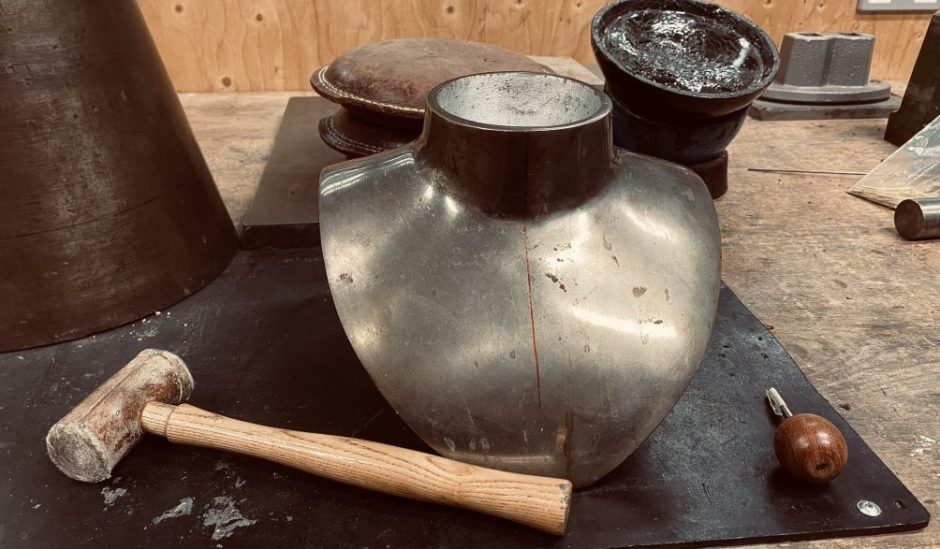“What’s it Worth?”
With the micro-teaching event I wanted to create a discussion on the concept of non-precious items of status and value. For this I chose to use Manillas, a cast bronze torque style item that resembles an open bangle that originate from the Kingdom of Benin now Nigeria.
These items were a common item of currency that were used for over 500 years for the purchase of goods but have come to be known in modern times as the currency used by Europeans for purchacing slaves for the Trans-Atlantic slave trade, much of them being cast in the British foundries in Birmingham, Sheffield and Macclesfield.
These objects held a great deal of social weight and even in their pre-Europeans use they were an item of status that often worn by the wives of wealthy merchants to show social and financial status by their wearing of around the ankles and wrists. Gold was still a precious commodity but these cast bronze objects were viewed as a highly desirable item.
Questions I wanted to discuss:
I wanted the participants to think about what makes an object of status so desirable?
What social and political gain and implications can be achieved through these objects?
To explore what materials these could be and look for modern examples
Is their a transients in these items where they seem so important today but in a period long or short they may be worthless.
Process:
3minutes – I initially asked the group to handle the objects and write a brief assessment of what they thought of the objects such as material, age, value function and origin.
5 minutes – I then when onto introduce the Manillas and give background to them which I feel was received well as nobody had come across them before.
3 minutes – Show and discuss other items of status
5 minutes – I then asked the group to think about and discuss the concept of status symbols and their significance and what contemporary examples might be.
2 minutes – Questions and brief discussion.
The discussion was quite fruitful with some interesting ideas being discussed such as the use of:
- Fashion items
- Technology
- Tulips
- The pineapple
- Foods
- Banded items and the power the brand itself holds in societies.
Feedback


Comments
“Would be great see this session with an object that has similar value and/ or purpose”
This is a great idea and would be a good addition to the discussion as part of an expansion of this topic, especially for a larger group or as part of the brief into for a making project maybe where students are asked to design their own concepts.


“Would have been nice to have more activities in this context”
I feel this was a weak point in my micro-teaching event, perhaps I simply had too much to say on the subject as it’s one that interests me greatly, I found this hard for the 20 minute time frame to build an activity for such a short session as I think it overall could be a good starting point for a bigger making project. I feel that to even get to a hands on activity point much needs to be talked about to establish a firm context.
This is definitely something I’m going to consider more for expanding this subject as a precursor to a wider project.

Question: How would you manage a session where someone might have a negative cultural/social/ emotional response to the object?
This is something I’d discussed with some colleagues prior to the teaching session and I understand that the Manillas have connotations to do with historical slave trade but I feel that we must put them in the correct context that they were simply a form of currency and not spesifically created as the currency of slave trade. They were used by Benin and early Europeans as means of currency to trade with the area and had the tradable items been a coinage Europeans would have worked with that.
The Manillas stands out I feel for a few reasons:
The shape and is not so recognisable to modern Europeans as a symbol of currency as coinage has been a mainstay for such a long period of history so the fact that they resemble a more individual item of jewellery perhaps we attach the significant role they played in the barbarism of the Trans-Atlantic slave trade. Coinage or more recognisable symbols feel more generic and perhaps harder to attach such significance to.
They were the native currency of the Benin area that Europeans bought into for general trade as well as other kingdoms in the area, Europeans monopolised on this as they were expert in the large scale foundry processes that could produce these and so it was a convenient payment method for many goods not specifically slaves in the early part of trading.
This is why the Manillas is such a strong example as the connections that can be made to an object that has such a simple but strong visual identity is greater and easier that those we deem generic or hard to distinguish from each other.
Question: What critical reflection would you hope students would take away from the excercise?
As I’ve touched on this above that I want students to understand that the associated value of objects are not necessarily connected to the material value itself, bronze was desired historically in Benin but gold also. It’s what commonly understood connotations we connect to the object that change the perceived social, political and financial value of objects, some of these are fleeting and some stay forever and become visual definitions.








